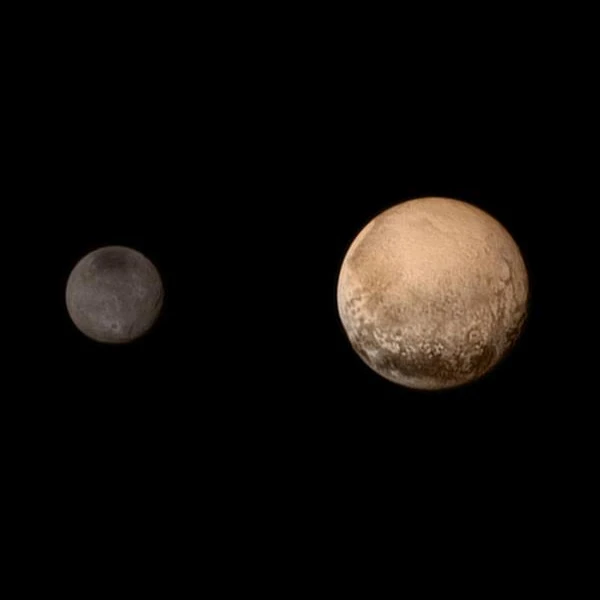
Pluto is a dwarf planet located in the Kuiper Belt, at the outer edge of the solar system. Since its redefinition in 2006 as a dwarf planet, interest in its lunar system has increased, especially after the New Horizons probe's flyby in 2015, which revealed unprecedented physical and dynamic details. Pluto has five known moons: Charon, the most massive, and four smaller moons named Nix, Hydra, Styx, and Kerberos. This system exhibits complex physical and orbital characteristics, indicative of a rich dynamic history.
Pluto has a diameter of about 2377 km and a mass of approximately \(1.309 \times 10^{22}\) kg. Its average density (\(\approx 1.86\) g/cm³) indicates a composition primarily of water ice mixed with a rocky core. Its main satellite, Charon, is relatively large (1212 km in diameter), with an exceptionally high size-to-Pluto ratio (about 0.5), making the Pluto-Charon system a binary system with synchronous rotation.
The other four moons are much smaller, with dimensions ranging approximately from 10 to 50 km, and more distant orbits. They orbit around the common barycenter of the system, with orbital periods in near resonance with each other, ensuring long-term dynamic stability.
| Satellite | Diameter (km) | Average Distance to Pluto (km) | Orbital Period (days) | Density (g/cm³) | Orbital Resonance |
|---|---|---|---|---|---|
| Charon | 1212 | 19,570 | 6.387 | ~1.70 | 1:1 (binary system) |
| Nix | ~50 | 48,700 | 24.9 | Unknown (probably <1.7) | 3:2 with Hydra |
| Hydra | ~50 | 64,800 | 38.2 | Unknown | 2:1 with Nix |
| Kerberos | ~19 | 57,800 | 32.1 | Unknown | Complex resonance with Nix and Hydra |
| Styx | ~16 | 42,700 | 20.2 | Unknown | Between Charon and Nix |
The relatively large size of Charon results in a common center of gravity located outside Pluto, characteristic of a binary system. This configuration influences the rotation and mutual tidal forces, leading to complete synchronization: Pluto and Charon always present the same face to each other.
From an energetic perspective, the dissipation of tidal forces through internal friction has allowed this mutual gravitational locking, with notable effects on the tectonics and geology of both bodies.
The small moons, with their resonant orbits, suggest a stable gravitational balance resulting from multi-body interactions. Their composition is assumed to be primarily icy, with lower densities than Charon, but precise data remain to be refined.
Their resonant orbital relationships ensure remarkable dynamic stability despite their small size and low mass.
The discovery of these minor moons has also allowed the study of debris dynamics and the potential formation of the system, hypothetically resulting from a giant impact on Pluto, similar to the hypothetical formation of our own Moon.
This scenario explains the composition and orbital arrangement of the satellites, while highlighting the complexity of gravitational interactions in this outer system of the solar system.
The New Horizons mission, launched in 2006 and flying by Pluto in July 2015, marked a major advance in the study of trans-Neptunian objects by collecting in situ data with unprecedented precision. Before this mission, our knowledge was mainly based on limited telescopic observations due to the distance, size, and low brightness of Pluto and its moons.
New Horizons provided high-resolution images showing the geological diversity of Pluto, revealing complex features such as water ice mountains, nitrogen ice plains (notably the Sputnik Planitia), fractures and faults caused by tectonic stresses, as well as evidence of cryovolcanism. This diversity indicates recent, or even current, geological activity, which was unexpected for a body of this size and distance from the Sun.
From a dynamic perspective, New Horizons allowed precise measurement of the orbital and physical parameters of Pluto's moons, including their sizes, shapes, compositions, and albedos. The images and spectra confirmed the predominantly icy composition of the secondary moons, with possible variations in the type of ice and contamination by organic materials or tholins.
The discovery of a tenuous but complex atmosphere around Pluto, mainly composed of nitrogen (\(N_2\)), methane (\(CH_4\)), and carbon monoxide (\(CO\)), has changed our understanding of sublimation, volatile cycles, and climate feedback in extreme cold environments. Stratified atmospheric haze layers have also been detected, indicating active atmospheric photochemistry.
New Horizons transformed Pluto from a distant and poorly understood dwarf planet into a natural laboratory for the study of the geophysics of small icy bodies, multi-body orbital dynamics, and chemical evolution in the outer regions of the solar system. These observations have profoundly influenced theoretical models of satellite formation, low-pressure atmospheres, and differentiated internal structures in the Kuiper Belt.
Source: NASA Solar System Exploration – Pluto, Science, New Horizons Mission, 2019, Icarus, 2018, Orbital Dynamics of Pluto's Satellites.